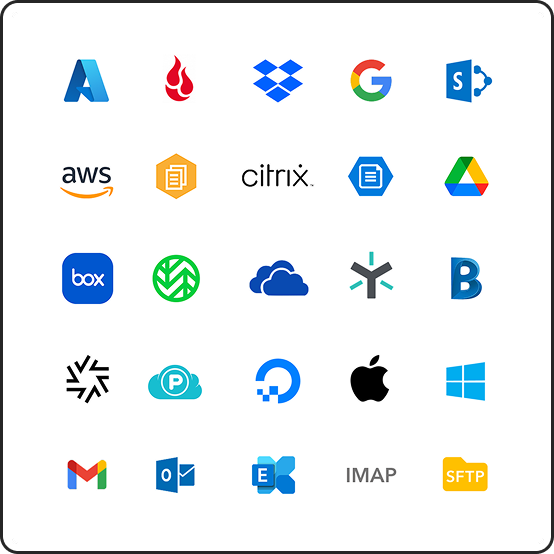With cloud computing becoming more popular, a lot of companies and organizations are looking to move data stored on on-premise devices to the cloud to take advantage of some of the many benefits. However, making that move hasn't always been straightforward, with a number of caveats and gotchas that could add up to make the move feel like it's not worth the trouble.
Movebot removes most of these and takes the pain points out of moving to the cloud.
If you're looking for a good method for how to move data to the cloud, Movebot is a solid choice, particularly when moving from on-prem to cloud storage like SharePoint, Google Workspace, or Dropbox.

Benefits of moving to the cloud
The vast majority of businesses already have data in the cloud, at least in some form. Most organizations have some kind of cloud storage, but many still keep important data on an on-premise server. While this is fine in some cases, there are many benefits to shifting this data to the cloud, such as not needing to manage hardware, easier collaboration, and increased security.
Hardware managed for you
Properly maintaining a file server takes work, and a lot of times it gets forgotten about. An old file server sitting in a closet somewhere is out of sight, out of mind. Until something goes wrong. And if it's been neglected for a while, there could be a lot wrong with it, like blocked exhaust, buildup where they shouldn't be, and so on.
Not only that, but hardware gets outdated fast, and a server that was state-of-the-art a decade ago will be outpaced by lower-end modern equivalents. Eventually, the hardware becomes inefficient and you'll need to upgrade to keep pace with advances in technology and software requirements. Continuous upgrades like this can get costly fast, and moving data to the cloud instead is a better alternative in many situations.
Easier collaboration
Both a pro and a con of on-prem file servers is that the files are stored in one place. From a security aspect, this can be a huge benefit--files can only be accessed in one place-- but it's also usually a single point of failure. If the one server goes out, that's it.
For collaboration having the files in one place is a huge challenge. Someone working in Des Moines can't easily share a file with someone in London, not to mention working on the same thing simultaneously.
This isn't a problem when files are in the cloud. Working on a project with cloud storage allows workers from all over the world to contribute and work with the same data. Updates are saved and stored, with many cloud storage providers having rollback features to quickly revert to a previous version, something that would need to be set up manually on a file server. When it comes to giving access, sharing, and collaborating, the cloud has a clear advantage.
Increased security
In many cases, cloud storage has enough security features to keep files safe (as long as you follow best practices), and come with methods to share and collaborate.
While file security in on-prem servers is excellent for closed networks, when the server is open to the public internet it's a different story. New exploits are being discovered constantly, and in the worst cases, these exploits can allow bad actors to get access to everything on the server. Most of the time these are patched out pretty quickly, but someone still has to add that patch for it to be effective.
In the cloud, these are applied at scale by a security team whose entire focus is making sure files stay safe. These and other advanced security protocols are all handled for you, meaning the chance of a significant breach is relatively low. If the server is simply a place to store files and a secure onsite location isn't required, moving to the cloud may be the better option.
For a deeper dive into the benefits of the cloud, see our article Why you should move your file server to the cloud.
How to move data to cloud storage with Movebot
If you think moving data to the cloud is right for you, then you should try Movebot as a fast, simple, and effective solution. Movebot uses a low-resource agent to connect your on-prem file server to your cloud storage destination, with a number of features to help make sure your data arrives quickly and in a usable format.
Check that your file server meets minimum requirements
In order to use Movebot, your server will need to meet a few requirements. The server that you want to migrate from needs 16GB of Memory and at least 32GB of free Hard Disk Space, along with a CPU with 4-8 VCPU cores. Windows XP isn't supported, but Windows 10 is, as well as Windows Server 2012 R12 and beyond.
Some other requirements involve firewall, network, and software requirements. To see a full list, see our documentation for Windows Fileservers Server Requirements.
Connect to your server using the Movebot Agent
Connecting your file server to Movebot takes a short series of steps for the initial setup, and from there you'll be able to move files from the server to any other storage platform you connect.
To start, log in to Movebot and add a new connection. Choose the appropriate option from the File Servers section such as Microsoft Windows/Apple OSX. A token will appear. Make sure to copy this token immediately and store it in a safe place. Once you close the window the token will disappear and can't be retrieved.
Next, download the agent by clicking the appropriate Windows or OSX Download button. You'll need to run the agent on the file server that you want to move files from. Run the agent on the file server and follow the setup process, which will ask for the token generated previously by Movebot. You can then test the connection both within the agent and in Movebot.
After the connection is successful, you won't need to repeat the steps again. Simply make sure that the agent is running on the server when you want to move files so that Movebot can connect and perform the migration. On Windows servers, you can set the agent to run as a service so you don't lose the connection.
Running the Migration
Movebot makes data migrations simple, and you're guided through a step-by-step process when setting up your migration. Follow the steps and choose content settings, with helpful features like automatic filename sanitization and deduplication that are enabled by default but can be switched off if you wish.
There are several other ways Movebot makes migrations simple too. One is that you can break down large projects into as many smaller moves as you want. You can even exclude content you don't want to move into cloud storage to reduce storage usage and keep the destination cleaner.
When you're happy with your setup, click to start the migration on your transfers and let Movebot handle the rest. And because of the way that Movebot handles delta migrations, users can keep working on the server while files are being moved. You can check stats about your migration at any time along with the generated post-migration report to make sure everything moved as expected.
After you run the migration, simply choose to run a delta migration, which searches for new and updated files and only moves those to the destination. Keep running these as needed until everything is moved across.
See the Movebot Blog for information on moving file servers to specific platforms, such as Migrating File Servers to SharePoint.
Expected Migration Speeds
On-prem file servers have an extra variable when it comes to speed, and that's the uplink speed of the server. This is a major contributor when it comes to estimating migration speed, as a slow connection can greatly increase how long it takes to move data to the cloud.
Ideally, you want to connect with the fastest available speed. If you can get 1GB or faster, then great--you'll see your migration fly. If you can't, just be aware that it may take longer due to this limitation and there's no way around it.
With Movebot, we expect that in most migrations your migration will move at half the theoretical maximum speed. See the table below for a breakdown of what a 5TB would take with different uplink speeds:
|
Data Rate
|
Expected daily data transfer with Movebot
|
Expected time to move 5TB
|
Comments
|
|
28.8 kb/s
|
1.24 GB/day
|
11 Years
|
Nope
|
|
50 Mbit
|
270 GB/day
|
3 Weeks
|
Pretty slow
|
|
100 Mbit
|
540 GB/day
|
9 Days
|
Starting to look reasonable
|
|
250 Mbit
|
1.35 TB/day
|
Half a Week
|
Not a crazy long time
|
|
500 Mbit
|
2.7 TB/day
|
1.5-2 Days
|
Getting faster
|
|
1 Gbit
|
5.4 TB/day
|
1 Day
|
In the fast lane
|
|
10 Gbit
|
54 TB/day
|
2-3 Hours
|
Lightning!
|
There's of course the factor of where you're moving to that will affect speed as well. Different cloud platforms have different limitations for how much and how fast you can move data into the platform.
Moving from the cloud to an on-prem server?
Movebot can do that too. If your organization has decided that having certain data in the cloud isn't right, Movebot can move files from cloud storage to a file server. Setup and configuration is nearly the same; simply swap the source and destination when you're setting up your project and you can move files to your server. As a cloud-agnostic data migration tool, you can use Movebot to move to and from file servers and any of the 30+ supported storage platforms.
Try Movebot for data migration from on premise to cloud
Moving data to the cloud doesn't have to be challenging. Movebot makes it easy with fast speeds, content transformation, scans and reports that keep you updated, and much more. Get all the benefits of the cloud and move your on-prem files quickly and easily to their new cloud storage home.
Interested to see how Movebot works for yourself? Give it a try with 50GB free, with no sales call or credit card required. Simply register for an account and you can connect your platforms and start moving data. Get started with your free trial now.






